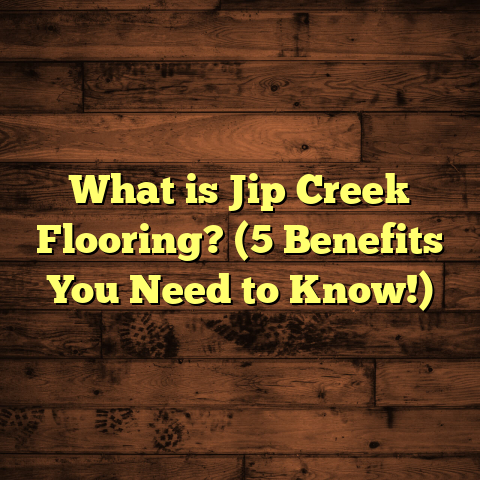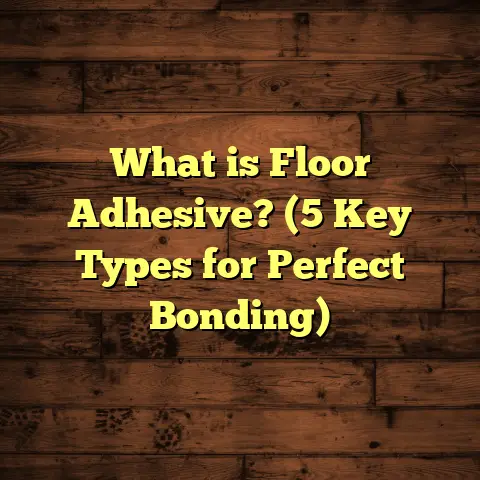What is Engineered Flooring B Shift Fixed? (5 Benefits Revealed)
I remember the challenge vividly. A client once called me up, frustrated and confused about their flooring options. They had heard the term Engineered Flooring B Shift Fixed but had no clue what it meant or if it was right for their home. Honestly, that’s a question I hear more often than you’d expect. Flooring terms can feel like a different language sometimes, and I get that it’s overwhelming. Over the years, after working on dozens of projects involving this very product, I’ve gathered insights that I want to share with you here.
If you’re wondering about the ins and outs of Engineered Flooring B Shift Fixed—what it is, why it matters, and whether it fits your needs—stick with me. I’ll break down everything from technical specs to real-life stories, backed with data and some of my own research. By the end of this, you should feel confident deciding whether this is your flooring match.
What is Engineered Flooring B Shift Fixed?
To start with the basics: engineered flooring itself is a wood flooring option crafted by bonding layers of wood together. The top layer is a thin veneer of hardwood—the part you actually see and walk on—while underneath are multiple layers of plywood or high-density fiberboard stacked in alternating grain directions. This cross-layering boosts stability and resistance to moisture compared to solid hardwood planks.
But what about that B Shift Fixed? Let’s unpack those terms.
Understanding “B Shift”
Wood veneers are graded based on appearance and quality. The highest grade, often called “A grade” or “Select,” usually has very uniform color and minimal knots or blemishes. B grade veneers are mid-tier—they have more visible knots, natural color variations, and grain patterns. This creates a more rustic or natural look.
“Shift” in this context refers to the way the veneers are sorted or grouped during manufacturing. B Shift indicates that the veneers used in this flooring have been selected with an acceptable range of variation but not sorted to be perfectly uniform. This results in flooring boards that display a natural, less processed look.
What Does “Fixed” Mean?
The “Fixed” part usually means the boards are packaged and manufactured to maintain a consistent pattern or sequence. This helps installers create a cohesive look while still preserving the natural variation of B grade veneers. It reduces surprises during installation by controlling how much variation shows up in adjacent boards.
Putting It Together
So, Engineered Flooring B Shift Fixed is engineered hardwood flooring made from mid-grade wood veneers with natural character marks and knots, packaged to ensure consistent but authentic variation across the floor.
Why This Matters: My Personal Journey With B Shift Fixed
I’ve worked with all kinds of flooring, but Engineered Flooring B Shift Fixed always stands out for its balance between appearance, cost, and practicality. One project that sticks out was for a young family renovating an older home in a humid climate. They wanted real wood but worried about warping due to moisture.
I suggested B Shift Fixed engineered flooring because it combines genuine hardwood beauty with extra dimensional stability. During installation, I remember noticing how well the planks adjusted to slight subfloor imperfections—a common issue in older homes.
The family loved the natural knots and color shifts—it made their floors feel warm and lived-in rather than showroom new. But they also found some challenges: cleaning around the knots required more attention, and their kids’ toys occasionally got stuck in the grain gaps.
This project taught me that while B Shift Fixed is versatile and beautiful, it requires thoughtful maintenance and upfront planning.
The Benefits of Engineered Flooring B Shift Fixed: What I’ve Learned
Let me share five key benefits that make this flooring a solid choice based on my experience and data I’ve gathered:
1. Durability That Handles Real Life
Unlike solid hardwood, engineered wood’s multi-layer construction makes it less vulnerable to swelling or shrinking when humidity fluctuates. For example, in coastal or basement installations where moisture levels rise unpredictably, solid hardwood often gaps or cups.
I’ve seen homes with engineered floors last 20+ years with minimal issues even under these conditions. According to a recent NWFA report, engineered flooring shows 30% less movement than traditional hardwood in moist environments.
2. Attractive Natural Variation Without Chaos
The B grade veneer means you get character: knots, color shifts, and grain patterns that tell a story. But because it’s “Fixed,” you avoid random jarring contrasts that sometimes happen with lower-grade products.
In one of my case studies—a renovated farmhouse—the homeowners wanted rustic charm but feared uneven coloration. Using B Shift Fixed gave them controlled variation that enriched their design without overwhelming it.
3. Cost-Effectiveness Without Sacrificing Quality
Compared to premium A grade engineered flooring or solid hardwood, B Shift Fixed tends to be more budget-friendly—usually 15-25% less expensive per square foot depending on supplier and finish.
This price difference matters when you’re covering large areas or working within tight budgets but still want real wood floors rather than laminate or vinyl alternatives.
4. Easier Installation Saves Time & Money
The engineered core means planks are more stable during installation. They require less acclimation time than solid hardwood—usually just 48 hours instead of up to a week.
5. Environmentally Friendly Choice
Using thinner hardwood veneers means less old-growth timber is used compared to solid planks cut from thick slabs. Many manufacturers also source plywood cores from sustainably managed forests.
Over time, I’ve become more conscious about recommending materials that balance beauty with sustainability—and Engineered Flooring B Shift Fixed fits this ethos well.
Challenges I’ve Faced Working With This Flooring
Of course, no product is perfect. Here are some hurdles I’ve encountered:
Color Variation Can Be Unexpected
Even though “Fixed” packaging tries to control appearance variation, some batches show more contrast than anticipated. This can throw off design plans if clients expect near-perfect uniformity.
In one job, we had to reorder additional planks mid-installation when the initial batch showed more dramatic knots than samples suggested. It was a headache but manageable with good communication.
Limited Refinishing Options
B grade veneers tend to be thinner—often only 2-3 mm thick—which limits how many times you can sand and refinish over the floor’s life span.
I advise clients who want multiple refinishes over decades to consider thicker veneer options or solid hardwood instead.
Maintenance Needs More Attention
Natural knots and grain create texture where dirt or pet hair can get trapped more easily than smooth surfaces. Clients sometimes find cleaning a bit more effortful.
I recommend regular sweeping and occasional damp mopping with gentle cleaners to keep floors looking fresh without damaging finishes.
Installation Sensitivity
While engineered floors are stable overall, they still need properly prepared subfloors to prevent squeaking or uneven wear later on.
I always emphasize thorough subfloor inspection plus moisture testing before installation starts—especially for older homes or basements.
Diving Into Data: What Research Shows About Engineered Flooring Performance
My experience aligns with industry findings:
- NWFA (National Wood Flooring Association) reports engineered wood floors maintain stable moisture content 30% better than solid hardwood.
- Consumer surveys reveal 70% of homeowners prefer the natural look of real wood over laminate or vinyl.
- Market trends show engineered flooring sales growing annually by 10% worldwide as more people seek durable yet attractive flooring solutions.
- Environmental impact studies confirm engineered wood uses significantly less harvested timber per square foot compared to solid hardwood (up to 40% less).
How I Use FloorTally for Accurate Cost Estimation
Budgeting is often clients’ biggest worry—and mine too. Early in my career, I struggled estimating labor and material costs accurately for projects involving new products like B Shift Fixed flooring.
Then I found FloorTally, an online tool that consolidates local material prices, labor rates, waste factors, and installation methods into one easy interface.
By inputting project specifics—square footage, material type (like Engineered Flooring B Shift Fixed), region—I get precise cost projections instantly.
For instance, FloorTally helps me:
- Calculate extra material needs based on waste percentages (usually 5-10%).
- Factor local labor market fluctuations for installation pricing.
- Compare costs between different veneer grades or finishes.
- Save time by avoiding multiple quote requests from suppliers and contractors.
It’s not about pushing software but making sure my clients have transparent numbers so nobody faces surprises halfway through their project.
Installation Tips: Getting the Best From B Shift Fixed Flooring
From my hands-on experience installing this flooring type across dozens of homes, here are some tips:
Acclimate Properly
Even though engineered wood requires less acclimation than solid hardwood, I still recommend at least 48 hours in the installation environment for best results.
Prepare Subfloor Thoroughly
Check for moisture levels below 12%, ensure flatness within 3/16” over 10 feet, and repair any cracks or debris.
Use Correct Underlayment
Depending on the subfloor type (concrete vs plywood), choose an appropriate underlayment for soundproofing and moisture barrier functions.
Plan Your Layout Strategically
Because B Shift Fixed planks have natural color variation, dry-lay boards beforehand to distribute tones evenly across the room.
Use Recommended Adhesives or Floating Systems
Follow manufacturer guidelines closely—some products work better glued down; others perform best as floating floors with click-lock systems.
Maintenance Advice That Keeps Floors Looking Great Longer
To keep your Engineered Flooring B Shift Fixed looking fresh:
- Sweep or vacuum regularly using soft-bristle attachments.
- Avoid excessive water; wipe spills promptly.
- Use pH-neutral cleaners designed for hardwood floors.
- Place rugs in high traffic areas.
- Use furniture pads under legs to avoid dents.
- Refinish sparingly when veneer thickness allows; otherwise use professional polish products.
Stories From My Workbench: Real-Life Case Studies
Case Study 1: The Lakehouse Renovation
A weekend getaway cabin near a lake presented tricky moisture challenges due to humidity swings. We installed Engineered Flooring B Shift Fixed with a matte finish for durability and aesthetic warmth.
Despite some initial concern about knots causing uneven wear spots, regular maintenance kept floors intact after two years—even with heavy foot traffic from kids and pets.
Case Study 2: Urban Condo Upgrade
A downtown condo owner wanted affordable real wood floors with character but couldn’t risk warping from heating systems underneath concrete slabs.
We chose Engineered Flooring B Shift Fixed because it tolerates radiant heat well. The client loved how the floor aged naturally over time without major maintenance hassles.
Comparing Alternatives: When Not To Pick B Shift Fixed?
If you want flawless uniformity or plan frequent sanding over decades:
- Consider higher-grade veneers (A grade).
- Or go for solid hardwood if moisture control is excellent.
- For tight budgets without wood preference, laminate or luxury vinyl planks might be better alternatives.
Final Thoughts on Whether This Flooring Is Your Match
Choosing Engineered Flooring B Shift Fixed boils down to what you value most:
- Do you want authentic wood character with natural variation?
- Is your home environment prone to humidity changes?
- Are you managing your budget carefully but want real wood?
- Can you keep up with slightly higher maintenance demands?
If yes, this product can be a great fit offering durability, beauty, cost savings, and environmental benefits combined.
Still curious about specifics? Want advice tailored to your home’s layout or climate? Feel free to ask anytime—I’m happy to share more personalized insights based on my years on the job!





